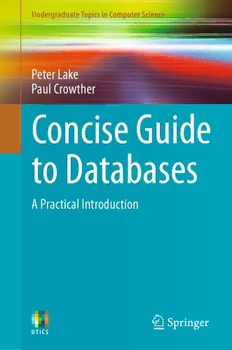
Concise Guide to Databases A Practical Introduction PDF
Preview Concise Guide to Databases A Practical Introduction
Undergraduate Topics in Computer Science Peter Lake Paul Crowther Concise Guide to Databases A Practical Introduction Undergraduate Topics in Computer Science UndergraduateTopicsinComputerScience(UTiCS)delivershigh-qualityinstructionalcontentforun- dergraduatesstudyinginallareasofcomputingandinformationscience.Fromcorefoundationaland theoreticalmaterialtofinal-yeartopicsandapplications,UTiCSbookstakeafresh,concise,andmod- ernapproachandareidealforself-studyorforaone-ortwo-semestercourse.Thetextsareallauthored byestablishedexpertsintheirfields,reviewedbyaninternationaladvisoryboard,andcontainnumer- ousexamplesandproblems.Manyincludefullyworkedsolutions. Forfurthervolumes: www.springer.com/series/7592 Peter Lake Paul Crowther ! Concise Guide to Databases A Practical Introduction Foreword by Professor Richard Hill PeterLake PaulCrowther SheffieldHallamUniversity SheffieldHallamUniversity Sheffield,UK Sheffield,UK Serieseditor IanMackie Advisoryboard SamsonAbramsky,UniversityofOxford,Oxford,UK KarinBreitman,PontificalCatholicUniversityofRiodeJaneiro,RiodeJaneiro,Brazil ChrisHankin,ImperialCollegeLondon,London,UK DexterKozen,CornellUniversity,Ithaca,USA AndrewPitts,UniversityofCambridge,Cambridge,UK HanneRiisNielson,TechnicalUniversityofDenmark,KongensLyngby,Denmark StevenSkiena,StonyBrookUniversity,StonyBrook,USA IainStewart,UniversityofDurham,Durham,UK ISSN1863-7310 ISSN2197-1781(electronic) UndergraduateTopicsinComputerScience ISBN978-1-4471-5600-0 ISBN978-1-4471-5601-7(eBook) DOI10.1007/978-1-4471-5601-7 SpringerLondonHeidelbergNewYorkDordrecht LibraryofCongressControlNumber:2013955488 ©Springer-VerlagLondon2013 Thisworkissubjecttocopyright.AllrightsarereservedbythePublisher,whetherthewholeorpartof thematerialisconcerned,specificallytherightsoftranslation,reprinting,reuseofillustrations,recitation, broadcasting,reproductiononmicrofilmsorinanyotherphysicalway,andtransmissionorinformation storageandretrieval,electronicadaptation,computersoftware,orbysimilarordissimilarmethodology nowknownorhereafterdeveloped.Exemptedfromthislegalreservationarebriefexcerptsinconnection with reviews or scholarly analysis or material supplied specifically for the purpose of being entered and executed on a computer system, for exclusive use by the purchaser of the work. Duplication of this publication or parts thereof is permitted only under the provisions of the Copyright Law of the Publisher’slocation,initscurrentversion,andpermissionforusemustalwaysbeobtainedfromSpringer. PermissionsforusemaybeobtainedthroughRightsLinkattheCopyrightClearanceCenter.Violations areliabletoprosecutionundertherespectiveCopyrightLaw. Theuseofgeneraldescriptivenames,registerednames,trademarks,servicemarks,etc.inthispublication doesnotimply,evenintheabsenceofaspecificstatement,thatsuchnamesareexemptfromtherelevant protectivelawsandregulationsandthereforefreeforgeneraluse. Whiletheadviceandinformationinthisbookarebelievedtobetrueandaccurateatthedateofpub- lication,neithertheauthorsnortheeditorsnorthepublishercanacceptanylegalresponsibilityforany errorsoromissionsthatmaybemade.Thepublishermakesnowarranty,expressorimplied,withrespect tothematerialcontainedherein. Printedonacid-freepaper SpringerispartofSpringerScience+BusinessMedia(www.springer.com) DedicatedtoourmateAndyMcEwan PaulandPeter Foreword Fromtabletsofstonethroughtolibrariesofparchments;frompaper-basedfilesto the electronic era, there is not one aspect of modern business that has avoided the needtocollect,collate,organizeandreportupondata.Theproliferationofdatabases anddatabasetechnologieswithinmoderntimes,hasnowbeenfurthersecuredbythe useoftheInternettoenabledatabaseintegrationonamassivescale. In amongst the innovation, the basic concepts remain. The need to organize— a topic that Codd reminded us could be best done by relational models—is now beingchallenged,asprocessorpowerandstoragespacebecomecheapandutility- likewiththeadventofCloudComputinginfrastructure.Butaglanceatthepastdoes muchtoinformfuturethinking,andthisbookservestopreparethefoundationsof amatureapproachtousingdatabasetechnologiesinthe21stCentury. Inmanycases,bothestablishedandemergingdatabasetechnologiesarereadily availableandfreetouse.Assuchtheymayappearfreetoimplement,whichfuels rapidadoptionoftechnologythatmaynothavebeenprovensufficiently,withoutthe formalgovernancethatotherbusinessnormsmightimpose.Thiscreatesanexciting, risky,domainwherecommercialmodelscanmakeorlosemoneydependingupon how they embraceandrealize the potentialof the technology.Conversely,there is also an opportunity to solve problems when things go awry—and the accelerated innovationthatwenowwitness,presentsmoreopportunitiesandpitfalls,ifwedo notpossesstherequisiteunderstandingofhowdatabasesshouldserveourneeds. Proficiencyinthefieldofdatabasesisacombinationoftechnicalunderstanding, conceptualknowledgeandbusinessacumen.Allofthesetraitsareunderpinnedby education, and the need for professionals to continually update their knowledge. Sinceprofessionalsnotonlyfacethechallengeofwhentointroduceatechnology, butalsowhennottoadopt,itisimportanttounderstandtheimpactoffailureaswell as success. This book takes readers through the essential basics, before charting a pathtowardstechnicalskillacquisitioninthereal-lifecontextofbusiness. HeadofSubject,ComputingandMathematics ProfessorRichardHill UniversityofDerby,Derby,UK June2013 vii viii Foreword AboutRichardHill: RichardHill,PhD,isProfessorofIntelligentSystemsandHeadofDepartmentintheSchoolof ComputingandMathematics,attheUniversityofDerby,UK.ProfessorHillhaspublishedwidely intheareasofmultiagentsystems,computationalintelligence,intelligentcloudcomputingand emergingtechnologiesfordistributedsystems,andhasorganisedanumberofinternationalconfer- ences.Latterly,ProfessorHillhaseditedandco-authoredseveralbookcollectionsandtextbooks, including‘GuidetoCloudComputing:PrinciplesandPractice’,publishedbySpringerUK. Preface OverviewandGoals Databasesarenotnewandtherearemanytextbooksavailablewhichcovervarious databasetypes,especiallyrelational.Whatischanging,however,isthatRelational DatabaseManagementSystems(RDBMS)arenolongertheonlydatabasesolution. InanerawhereBigDataisthecurrentbuzzwordandDataScientistsaretomorrow’s bigearners,itisimportanttotakeawiderviewofdatabasetechnology. Keyobjectivesforthisbookinclude: PresentanunderstandingofthekeytechnologiesinvolvedinDatabaseSystems • ingeneralandplacethosetechnologiesinanhistoriccontext Explore the potential use of a variety of database types in a business environ- • ment Pointoutareasforfurtherresearchinafastmovingdomain • Equip readers with an understanding of the important aspects of a database • professional’sjob Providesomehands-onexperiencetofurtherassistintheunderstandingofthe • technologiesinvolved OrganisationandFeatures Thisbookisorganisedintothreeparts: PartIintroducesdatabaseconceptsandplacestheminbothahistoricandbusi- • nesscontext; Part II provides insights into some of the major database types around today • andalsoprovidessomehands-ontutorialsintheareasconcerned; PartIIIisdevotedtoissuesandchallengeswhichfaceDatabaseProfessionals. • TargetAudiences Thisbookhasbeenwrittenspecificallytosupportthefollowingaudiences: Advanced undergraduate students and postgraduate students should find the combination of theoretical and practical examples database usage of interest. We imagine this text would be of particular relevance for modern Computer Science, ix x Preface Software Engineering, and Information Technology courses. However, any course that makes reference to databases, and in particular to the latest developments in computingwillfindthistextbookofuse.Assuch,UniversityInstructorsmayadopt thebookasacoretext. Especially in Part II, this book adopts a learning-by-doing approach, with the extensiveworkedexamplesexplaininghowtousethevarietyofdatabasesavailable toaddresstoday’sbusinessneeds.PractisingDatabaseProfessionals,andApplica- tionDeveloperswillalsobeabletousethisbooktoreviewthecurrentstateofthe databasedomain. SuggestedUses AConciseGuidetoDatabasescanbeusedasasolidintroductiontotheconceptof databases.Thebookissuitableasbothacomprehensiveintroductiontodatabases, as well as a reference text as the reader develops their skills and abilities through practicalapplicationoftheideas.ForUniversityInstructors,wesuggestthefollow- ingprogrammeofstudyforatwelve-weeksemesterformat: Weeks1–3:PartI • Weeks4–8:PartII • Weeks9–12:PartIII • Week12:Assessment • ReviewQuestions Eachchapterconcludeswithasetofreviewquestionsthatmakespecificreference to the content presented in the chapter, plus an additional set of further questions thatwillrequirefurtherresearch.Thereviewquestionsaredesignedinsuchaway thatthereaderwillbeabletotacklethembasedonthechaptercontents.Theyare followed by discussion questions, that often require research, extended reading of othermaterialordiscussionandcollaboration.Thesecanbeusedasclassroomdis- cussiontopicsbytutorsorusedasthebasisofsummativeassignments. Hands-onExercises The technology chapters include extended hands-on exercises. Readers will then progressively engage in more complex activities, building skills and knowledge alongtheway.Suchanapproachensuresthatasolidfoundationisbuiltbeforemore advancedtopicsareundertaken.Someofthematerialhereis OpenSource,whilst someexamplesareOraclespecific,buteventheselattercanbeappliedtootherSQL databases.
